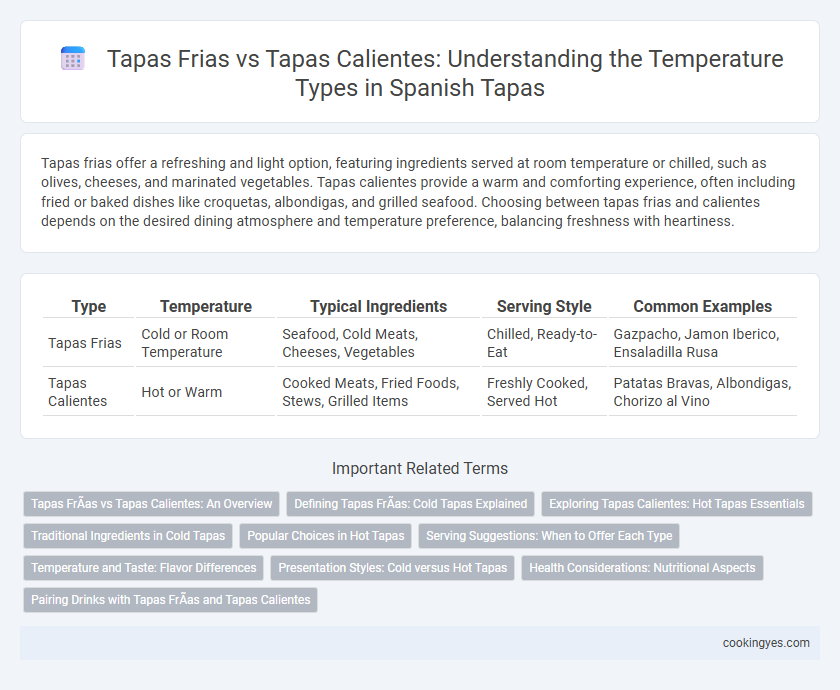Tapas frias offer a refreshing and light option, featuring ingredients served at room temperature or chilled, such as olives, cheeses, and marinated vegetables. Tapas calientes provide a warm and comforting experience, often including fried or baked dishes like croquetas, albondigas, and grilled seafood. Choosing between tapas frias and calientes depends on the desired dining atmosphere and temperature preference, balancing freshness with heartiness.
Table of Comparison
| Type | Temperature | Typical Ingredients | Serving Style | Common Examples |
|---|---|---|---|---|
| Tapas Frias | Cold or Room Temperature | Seafood, Cold Meats, Cheeses, Vegetables | Chilled, Ready-to-Eat | Gazpacho, Jamon Iberico, Ensaladilla Rusa |
| Tapas Calientes | Hot or Warm | Cooked Meats, Fried Foods, Stews, Grilled Items | Freshly Cooked, Served Hot | Patatas Bravas, Albondigas, Chorizo al Vino |
Tapas Frías vs Tapas Calientes: An Overview
Tapas frias and tapas calientes represent two distinct temperature categories in Spanish cuisine, with tapas frias served cold or at room temperature, often featuring ingredients like marinated vegetables, olives, cheeses, and cured meats. Tapas calientes are served hot, including dishes such as patatas bravas, croquetas, and grilled seafood, offering a warm and often fried or baked texture. The choice between tapas frias and calientes influences the dining experience by balancing refreshment with warmth, catering to seasonal preferences and complementing different beverage pairings.
Defining Tapas Frías: Cold Tapas Explained
Tapas frias, or cold tapas, consist of chilled or room-temperature dishes such as gazpacho, marinated olives, and cured meats that highlight fresh, vibrant flavors without heating. These cold tapas emphasize ease of preparation and preserve the natural taste and texture of ingredients like seafood, vegetables, and cheeses. Popular in warmer climates, tapas frias provide a refreshing contrast to the rich and often spiced hot tapas calientes.
Exploring Tapas Calientes: Hot Tapas Essentials
Tapas calientes offer a warm, flavorful experience featuring dishes like patatas bravas, albondigas, and gambas al ajillo, which highlight the rich, hearty nature of Spanish cuisine. These hot tapas are often prepared with fresh ingredients and spices that enhance their aroma and taste, making them ideal for sharing during social gatherings. Exploring tapas calientes reveals the importance of temperature and texture in delivering authentic, sizzling bites that contrast with the cooler, lighter tapas frias.
Traditional Ingredients in Cold Tapas
Cold tapas, or tapas frias, traditionally feature ingredients such as cured meats like jamon iberico, marinated olives, fresh seafood like anchovies or shrimp, and crisp vegetables including tomatoes and peppers. These ingredients are often combined with olive oil, garlic, and vinegar to enhance natural flavors without heating, preserving freshness and texture. Unlike hot tapas, cold tapas emphasize the use of raw or chilled elements, making them ideal for balancing temperature variety in Spanish cuisine.
Popular Choices in Hot Tapas
Popular choices in hot tapas include dishes like patatas bravas, albondigas, and gambas al ajillo, known for their rich, savory flavors and warm serving temperature. These hot tapas often feature ingredients such as garlic, paprika, and olive oil, enhancing their aromatic and spicy profiles. Serving tapas calientes maintains the ideal heat to intensify taste and provide a comforting, satisfying experience typical of Spanish cuisine.
Serving Suggestions: When to Offer Each Type
Tapas frias are ideal for warm weather or outdoor gatherings, as they provide a refreshing and light option that can be served chilled or at room temperature, enhancing the dining experience without the need for reheating. Tapas calientes are best suited for cooler evenings or indoor settings, offering comforting and flavorful dishes served hot to invigorate guests. Choosing between cold and hot tapas depends on the ambiance, season, and the desired balance of temperature and taste during the meal.
Temperature and Taste: Flavor Differences
Tapas frias, served chilled or at room temperature, emphasize fresh, vibrant flavors such as tangy marinated vegetables and chilled seafood, enhancing their natural crispness and acidity. Tapas calientes, served hot, offer rich, intense tastes like melted cheese, warm olives, and spiced meats, which deepen flavor complexity and texture through heat. Temperature plays a crucial role in taste perception, with frio tapas highlighting brightness and calor tapas boosting savory, hearty notes.
Presentation Styles: Cold versus Hot Tapas
Cold tapas (tapas frias) often feature visually appealing presentations with vibrant colors and fresh ingredients like chilled seafood, cured meats, and marinated vegetables served on sleek plates or small bowls. Hot tapas (tapas calientes) emphasize warmth and texture, commonly presented as sizzling dishes or baked items in traditional cazuelas, enhancing the sensory experience with steam and aroma. Both styles showcase distinct plating techniques that highlight their temperature contrast, enhancing the overall dining appeal and inviting diverse tasting experiences.
Health Considerations: Nutritional Aspects
Cold tapas often retain more vitamins and antioxidants due to minimal heat exposure, making them beneficial for preserving nutrients like vitamin C and folate. Hot tapas can enhance the bioavailability of certain nutrients, such as lycopene in tomatoes, but may also lead to nutrient loss from prolonged cooking. Balancing cold and hot tapas in a diet ensures a diverse intake of essential nutrients while supporting digestive health through varied textures and temperatures.
Pairing Drinks with Tapas Frías and Tapas Calientes
Tapas frias, such as gazpacho, olives, and cured meats, pair perfectly with crisp white wines, chilled sherries, or light beers to enhance their refreshing and delicate flavors. Tapas calientes, including patatas bravas, albondigas, and grilled chorizo, are best matched with robust red wines, aged sherries, or malty beers that complement their rich, warm profiles. Selecting drinks based on the temperature and intensity of tapas maximizes the harmony between food and beverage, creating a balanced and enjoyable dining experience.
Tapas frías vs Tapas calientes for temperature types Infographic

 cookingyes.com
cookingyes.com